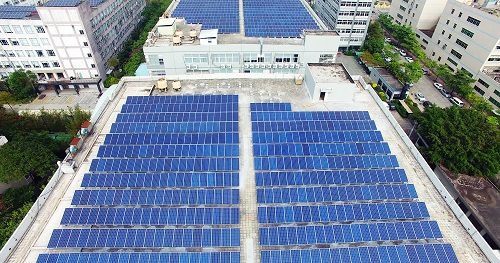By all accounts, New York City real estate values have been significantly impaired by the COVID-19 pandemic. Thousands of businesses have suffered catastrophic economic losses, as have the landlords who own the buildings in which they operate. And without both a successful vaccine and more government stimulus, the commercial real estate industry will continue to struggle.

However, while the city tries to solve this public health crisis, there is another significant continuing challenge which will remain well after the pandemic: climate change. The Earth is still warming at an unhealthy rate because of greenhouse gas emissions. 2020 has been one of the hottest years on record so far, and the past seven years have been the seven hottest years for the planet overall.
More flooding has occurred this year as well. According to the National Oceanic and Atmospheric Administration, the southern tip of Manhattan has flooded 10 times from May 2019 to April 2020, as compared to 20 years ago when the Battery would flood less than five times per year. Sea levels are reaching all-time highs all along the Atlantic seaboard. In fact, New York is the #3 ranked city in the world in terms of risk of loss to asset value due to sea-level rise, after only Miami, Florida and Guangzhou, China.
Lawmakers in New York City acknowledged the threat of climate change with the recent passage of the Climate Mobilization Act, which will soon impose statutory limitations on the amount of carbon emissions a property can legally add to the atmosphere. One of the driving forces behind the law’s impact will be the implementation of a new commercial property assessed clean energy (“C-PACE”) lending program designed to finance energy-efficient improvements and thus drive down carbon footprints. The degree to which C-PACE will prove to be an effective catalyst in making the city greener will depend in large part on whether mortgage lenders will allow their real estate collateral to be encumbered by the special assessments created by C-PACE financing.
In this article, we will:
- discuss the Climate Mobilization Act and the requirements set forth in Local Law 97 for decreasing the carbon emissions of New York City buildings;
- summarize the legal structure and practical benefits of C-PACE financing; and
- explain how first mortgage lenders, including those originating loans intended to be bundled, tranched and sold as bonds in a commercial mortgage-backed securitization (CMBS), can structure their financings to accommodate a C-PACE financing.
With some careful drafting and targeted due diligence, lenders can minimize the risk to their collateral while achieving other beneficial goals. By consenting to the C-PACE financing, they will help their borrowers incur lower operating expenses, drive up property values and operate more energy-efficient buildings. Together, bankers and property owners can be part of the climate change solution.
The Climate Mobilization Act

In May 2019, the New York City Council passed the Climate Mobilization Act (the “Act”). One of the most important parts of the Act, Local Law 97, requires all new and existing buildings larger than 25,000 square feet to reduce their carbon emissions by 40% by the year 2030, and by 80% by the year 2050. There are over one million buildings in New York City, and this law will apply to the largest 50,000 of that total. Buildings are the city’s largest source of greenhouse gas emissions, accounting for roughly 70% of emissions, primarily from generating electricity for lights and appliances and burning oil and gas for heat and hot water.
A new city agency called the Office of Building Energy and Emissions Performance will enforce the rules of the Act and require annual reporting (with filing fees) by building owners to provide evidence of compliance. The new law requires energy audits to be performed by registered design professionals to assist the agency’s enforcement efforts. Local Law 97 creates two initial compliance periods. Approximately 20% of buildings covered by the law must comply from 2024 to 2029. Approximately 75% of the covered buildings will have to comply with stricter greenhouse gas limits from 2030 to 2034. Beginning with the 2024 compliance deadline, building owners in violation of the law can be charged with multi-million dollar fines each year. The fines could reach up to US$268 per ton of emissions above the legal cap, and up to US$5 million for a single property per year.
The first deadline for compliance with the Act is less than a year away. On or prior to July 1, 2021, building owners may apply to the NYC Department of Buildings (the “DOB”) for adjustments to the building emissions limits set forth in the Act. To qualify for such an adjustment, building owners are obligated to take advantage of any available loan or grant opportunities for energy efficiency retrofits, such as C-PACE loans and other New York State and U.S. government grant and loan programs. Even after he uncertainty caused by the COVID-19 pandemic, this July 2021 deadline and other key benchmarks under the Act have not been extended.
Local Law 97 allows for adjustments to a building’s emissions cap if the owner can show “financial hardship” or if compliance would prevent the owner from “earning a reasonable financial return on the use of such building.” The DOB is expected to release an application for such an adjustment after recommendations are submitted to the Mayor in January 2023. It is hard to imagine any business that did not suffer a financial hardship during 2020. As the law is currently written, it is likely this provision could significantly lessen the impact of Local Law 97 given the effects of COVID-19 on New York City commercial real estate owners. However, the government has not indicated whether pandemic-related hardship will be taken into account in either granting or denying adjustment claims.
Local Law 97 also includes a provision that the city must study cap-and-trade programs for building owners. Some argue that carbon trading (also known as cap-and-trade programs) is the ideal solution for the implementation of the city’s emissions reduction plan under the Act. Cap-and-trade programs have been embraced around the world, including Tokyo which initiated its program in 2010. In New York City, a cap-and-trade program would allow for property owners below the applicable greenhouse gas limits to sell “credits” to property owners that exceed the emissions limits. The buying and selling of credits would create a market price for carbon and the resultant market dynamics would then drive capital expenditure and investment decisions. The feasibility study for a cap-and-trade program is expected to be submitted to the Mayor and Speaker of the City Council by January 1, 2021. A city advisory board has been meeting remotely during the pandemic to study the idea, but their meetings are not open to the public. Therefore, there is little known about the current status of the study.
COVID-19 has created a myriad of uncertainty regarding the Act and building owners’ expected compliance with Local Law 97. Because of the significant decrease in economic activity over the past several months, many building owners are unlikely to have enough available cash flow to pay for the energy-efficient improvements necessary to meet the Act’s strict requirements. However, since many key deadlines have not been extended, property owners should be taking steps to prepare for compliance by looking into green property retrofits and exploring C-PACE financing programs.
C-PACE in New York City

It is clear that many New York City building owners will need to make a number of green improvements to their properties in order to comply with the Act. Hopefully soon, the owner/developer community will be able to look to C-PACE financing as a way to meet their Local Law 97 emissions reduction targets. Local Law 96, which was also included in the Act, enabled C-PACE financing in New York City for the first time. The program cannot be established, however, until the city first issues draft rules and then allows for a public review and comment period. These rules will ultimately create the framework for how the program will be administered on a day-to-day basis by the city. The New York City Energy Efficiency Corporation, a non-profit body that will administer New York City’s C-PACE program, was due to begin accepting loan applications in early 2020. However, the roll-out has stalled by the COVID-19 pandemic. While we wait for the details of New York City’s C-PACE program to be formally enacted, a general overview of how C-PACE lending works is summarized as follows.
C-PACE financing is a type of low-cost, long-term financing aimed at making commercial properties more green by creating greater energy efficiency and lowering the carbon footprint of the underlying building. Property owners voluntarily choose to participate in a C-PACE program to finance the costs of certain clean energy improvements. Typically, a C-PACE program is run by a designated state or municipal agency or department, while the financing itself is funded by a private, third-party lender. The program administrator will refer the property owner to a list of eligible lenders. The building owner completes a loan application where, among other things, the underlying building improvements to be funded must qualify as being green. Common examples of such qualified energy-efficient improvements include LED lighting, high-efficiency HVAC, window replacements with insulation and low-emissivity glazing, energy recovery units, variable refrigerant flow heat pumps, low-flow plumbing and rooftop solar installations.
While C-PACE financing is secured by the property, the security is not established by recording a mortgage in the public records. Instead, it is secured by a special assessment against the property and is repaid as part of the owner’s real estate tax bill. Payments are due on the same schedule as the applicable real estate taxes, whether on an annual or semi-annual basis. Also like real estate taxes, the C-PACE assessment primes any mortgage on the property. This advantage in lien priority is written into the applicable laws with public policy in mind to incentivize private lenders to agree to finance projects that improve the energy efficiencies of commercial buildings. A typical C-PACE financing has roughly a 20-30 year term and is fully amortizing. This is also by design to match the useful life of the qualified improvement. C-PACE loans are non-recourse, and are underwritten to the underlying property value, rather than the owner or sponsor. As such, no parent guaranty is required. C-PACE loans run with the land and are legally binding on successor owners, including a foreclosing mortgage lender. Upon a default under a C-PACE financing, the applicable C-PACE loan cannot be accelerated. Any foreclosure of the C-PACE assessment lien is limited to past due payments only. A foreclosing mortgage lender who steps into the shoes of a property owner who defaulted under a C-PACE loan does not then owe the full amount of the C-PACE loan, but rather only the past due payments. Going forward, however, any remaining future assessment amounts continue to be payable by the successor owner on the original amortization schedule.
The structure of C-PACE loans makes them uniquely attractive to borrowers in comparison to traditional financing for many reasons. Due to the ability to create a superior lien on the real property where the improvements are being constructed, interest rates are typically lower than a traditional mezzanine loan. This reduces the overall cost of capital to the borrower. Further, no equity investment by the borrower is required because C-PACE financing can cover 100% of both hard and soft costs. This varies from traditional bank loans which often only cover hard costs and lend at far less than 100% loan-to-cost. Since the C-PACE assessment payments are spread out over a long term, the resulting utility savings for a property owner will be significant, driving property value up and operating expenses down. There is also an accounting advantage for property owners. Companies do not have to directly account for C-PACE loans as debt, as they are technically classified as a special assessment and paid as part of regular property taxes. Finally, as mentioned above, no personal guaranties by the owner are required, unlike in typical construction or bank loans where sponsor guaranties are common and heavily negotiated at considerable expense during the origination process.
Once the program starts in New York City, C-PACE financing will allow building owners to obtain loans from private companies at a cheaper cost than traditional financing to pay for energy-efficient building improvements over time. It will also help developers to meet the Local Law 97 emissions reductions requirements at an affordable cost. As compliance deadlines are quickly approaching, it is expected that C-PACE will have immediate popularity with New York City building owners. The key to unlocking the full potential of this climate change tool, however, lies at the doorstep of the most important third party to any C-PACE loan: the consent of the mortgage lender.
Mortgage Lenders and C-PACE

Mortgage lenders, including CMBS lenders, customarily do not allow any type of additional financing on the underlying property securing their loans. This concern is most strict with respect to any other debt that would be superior to, or equal in priority to, the mortgage lien. Given their special lien priority status, most commercial mortgage loan documents prohibit the borrower from taking out a C-PACE loan. In fact, the mortgage loan documents typically provide that C-PACE loans are expressly prohibited without the prior written consent of the mortgage lender. Accordingly, C-PACE loans constitute prohibited indebtedness that would give rise to an event of default under the mortgage loan. A C-PACE loan in violation of the loan documents would also trigger recourse liability to the sponsor under a typical non-recourse carve-out guaranty. However, the risk to mortgage lenders in approving a C-PACE financing is low if the right structural mitigants are hardwired into the loan documents. As a result, the categorical ban by mortgage lenders on C-PACE loans should be reevaluated, especially in New York City in light of the Act and Local Law 97. There are many prudent changes mortgage lenders can make to their loan documents to minimize the risk of a C-PACE loan defaulting and priming the mortgage loan.
First, mortgage lenders should require all required C-PACE assessments to be reserved with the lender in escrow. The reserve can be collected upfront at the closing, or on a monthly basis over the term of the loan. The lender can then ensure, similar to real estate taxes, that all C-PACE assessments are paid in a timely manner. This reserve would look and function like a typical real estate tax reserve. Under the loan documents, the lender would have the right to apply these designated reserve funds to the payment of the C-PACE assessments. To collect the required monthly deposits, the lender’s cash management agreement can be structured to include a new sub-account in the cash management waterfall. Given that the C-PACE assessments have the same lien priority as real estate taxes, the C-PACE reserve should be one of the first sub-accounts in the waterfall to be filled, before debt service, operating expenses and other reserves.
Second, the C-PACE financing should be part of the mortgage lender’s due diligence conducted prior to making the loan. The C-PACE documents should be reviewed, and all of the material terms and conditions should be discussed with lender’s counsel. In addition, the title commitment obtained as part of the lender’s due diligence should also be reviewed to ensure that there are no past-due C-PACE assessments. The lender should include the C-PACE financing, and the assessments thereunder, in its underwriting as part of the property’s operating expenses. To support the due diligence and underwriting of the mortgage loan, the lender should require as a condition to closing the execution and delivery of an estoppel certificate from the C-PACE lender. The estoppel should contain certifications as to the full list of the C-PACE documents, that there have been no amendments to the same, that all assessments have been paid to date and that there are no defaults or events of defaults. The estoppel should also expressly acknowledge that the mortgage lender has the right, but not the obligation, to make the required assessment payments directly, and that the C-PACE lender will accept those payments. Ideally, the estoppel would grant the mortgage lender the right to receive notices under the C-PACE documents concurrently with the borrower thereunder, and cure rights to remedy any defaults under the C-PACE documents.
Loan Documents
With respect to the loan documents themselves, mortgage lenders should consider adding the following inserts to their form loan agreements to allow for C-PACE financing that exists as of the origination date of the loan. Similar changes should also be made to the mortgage, recourse guaranty and environmental indemnity agreement, as applicable.
-
- “C-PACE Loan” shall mean the financing secured by the Property made pursuant to the C-PACE Loan Documents.”
- “C-PACE Loan Documents” shall mean those certain financing documents listed on Exhibit [__] attached hereto.”
- “C-PACE Loan” shall mean the financing secured by the Property made pursuant to the C-PACE Loan Documents.”
-
- “Borrower hereby represents as of the Closing Date that (a) the C-PACE Loan was made on [______], 20[__] to finance the cost of [_____________], [which improvements have been completed as of the date hereof,] (b) the current outstanding principal balance of the C-PACE Loan is $[______], (c) the C-PACE Loan Documents are in full force and effect and have not been amended, restated, replaced or otherwise modified (except, in each case, as expressly set forth herein), (d) there are no defaults under the C-PACE Loan Documents by any party thereto and, to Borrower’s knowledge, no event has occurred which, but for the passage of time, the giving of notice, or both, would constitute a default under the C-PACE Loan Documents, (e) all amounts due and payable under the C-PACE Loan Documents have been paid in full, (f) no party to the C-PACE Loan Documents has commenced any action or given or received any notice for the purpose of terminating the C-PACE Loan Documents, (g) the representations made in any estoppel or similar document delivered with respect to the C-PACE Loan Documents in connection with the Loan are true, complete and correct and are hereby incorporated by reference as if fully set forth herein, and (h) Borrower knows of no basis for any additional assessment relating to the C-PACE Loan other than as set forth in the C-PACE Loan Documents.”
-
- “Borrower shall (i) pay all amounts due and owing under the C-PACE Loan Documents as the same become due and payable, and perform all of the covenants and agreements required to be performed under the C-PACE Loan Documents; (ii) promptly notify Lender of any default under the C-PACE Loan Documents; (iii) promptly deliver to Lender a copy of any notice received by it under the C-PACE Loan Documents; (iv) enforce the performance and observance of all of the covenants and agreements required to be performed and/or observed under the C-PACE Loan Documents; (v) cause the Property to be operated in accordance with the C-PACE Loan Documents; and (vi) not, without the prior written consent of Lender, (A) enter into any new C-PACE Loan Documents or replace or execute modifications to any existing C-PACE Loan Documents or renew or extend the same, (B) surrender, terminate or cancel the C-PACE Loan Documents, (C) reduce or consent to the reduction of the term of the C-PACE Loan Documents, (D) increase or consent to the increase of the amount of any charges under the C-PACE Loan Documents, or (E) following the occurrence and during the continuance of an Event of Default, exercise any rights, make any decisions, grant any approvals or otherwise take any action under the C-PACE Loan Documents.”
- “Borrower shall deliver to Lender, within ten (10) days of request, estoppel certificates from each party under any C-PACE Loan Documents in form and substance acceptable to Lender.”
- “Borrower shall (i) pay all amounts due and owing under the C-PACE Loan Documents as the same become due and payable, and perform all of the covenants and agreements required to be performed under the C-PACE Loan Documents; (ii) promptly notify Lender of any default under the C-PACE Loan Documents; (iii) promptly deliver to Lender a copy of any notice received by it under the C-PACE Loan Documents; (iv) enforce the performance and observance of all of the covenants and agreements required to be performed and/or observed under the C-PACE Loan Documents; (v) cause the Property to be operated in accordance with the C-PACE Loan Documents; and (vi) not, without the prior written consent of Lender, (A) enter into any new C-PACE Loan Documents or replace or execute modifications to any existing C-PACE Loan Documents or renew or extend the same, (B) surrender, terminate or cancel the C-PACE Loan Documents, (C) reduce or consent to the reduction of the term of the C-PACE Loan Documents, (D) increase or consent to the increase of the amount of any charges under the C-PACE Loan Documents, or (E) following the occurrence and during the continuance of an Event of Default, exercise any rights, make any decisions, grant any approvals or otherwise take any action under the C-PACE Loan Documents.”
-
- It shall be an Event of Default “if (A) Borrower shall fail (beyond any applicable notice or grace period) to pay any assessments or other charges payable under any C-PACE Loan Documents as and when payable thereunder, (B) Borrower defaults under the C-PACE Loan Documents beyond the expiration of applicable notice and grace periods, if any, thereunder, (C) if the Property becomes subject to any lien on account of the C-PACE Loan Documents, or (D) any of the C-PACE Loan Documents are amended, supplemented, replaced, restated or otherwise modified without Lender’s prior written consent.”
-
- The C-PACE Loan shall be both a “Permitted Transfer” and a “Permitted Encumbrance.”
-
- It shall be an event giving rise to recourse liability to the extent of any losses suffered by Lender in connection with “(A) any violation or breach of the C-PACE Loan Documents, or (B) if Borrower’s failure to pay any amounts due and payable under the C-PACE Loan Documents creates any lien on the Property.”
- It shall be an event giving rise to recourse liability for the full amount of the mortgage loan debt if “any of the C-PACE Loan Documents are amended, supplemented, replaced, restated or otherwise modified without Lender’s prior written consent or Borrower fails to obtain Lender’s prior written consent to any additional C-PACE financing.”
The mortgage loan documents can also be structured to permit future C-PACE financing after origination of the mortgage loan by incorporating the foregoing as conditions precedent. In this situation, other conditions would include adequate prior written notice to the mortgage lender, the absence of any event of default under the loan, a financial metric test taking into account the total amount of the C-PACE financing, a satisfactory updated title search, and payment of the lender’s out-of pocket costs and expenses. The mortgage lender’s prior written consent should also be a condition, as well as receipt of a rating agency confirmation if the loan is intended for securitization in the CMBS market. It should be noted that when lenders make CMBS mortgage loans, the general rule is that C-PACE financings are expressly not allowed and are treated as prohibited debt. The rating agencies who rate CMBS bonds would typically flag a C-PACE financing as a credit negative factor. However, this strict position may be relaxed in the future. There is evidence in the securitization market that rating agencies are more closely analyzing the financial risks associated with climate change, as investors demand more information on climate related impacts. Last year, Fitch Ratings announced it would become the first major rating agency to include natural disaster and catastrophic risk into the ratings analysis of residential mortgage-backed securities. Earlier this year, Moody’s Investor Services began adding new climate change data to its customary credit reports for CMBS deals. As the rating agencies continue to incorporate climate change into their research and ratings and as ESG focused bond buyers request more data about how climate change will impact a property’s energy bills, insurance premiums and capital expenditure costs, it may not be long before the agencies agree to permit C-PACE financings as part of a deal’s capital stack, assuming the documents contain all reasonably necessary structural mitigants.
One final point on loan documents: it has been argued that for mortgage lenders to approve a C-PACE financing a tri-party agreement (akin to a co-lender or mezzanine intercreditor agreement) between the lenders is necessary. Although this would constitute an additional layer of legal protection for the mortgage lender, it is likely to cause undue delay and expense and be duplicative of the mortgage loan documents in many ways. Because C-PACE financing is more like real estate taxes than a second mortgage or a mezzanine loan, the more practical and efficient approach is to incorporate the various protections outlined in this article. With these loan document enhancements and due diligence steps, the mortgage lender can minimize the risk of default on the C-PACE financing. At the same time, it will allow its borrower to undertake an energy-efficient property improvement that not only increases the value of the property by reducing operating expenses but also reduces the carbon footprint of the building.
Conclusion
While still dealing with the pandemic, the New York City commercial real estate market is at a crossroads. When will workers permanently return to their Midtown offices, either full-time or under a hybrid arrangement? Will companies downsize their office space? When will 5th Avenue retail and 90%+ hotel occupancy come back? When will Madison Square Garden and Broadway reopen to thousands of spectators? While the answers to these questions are up for debate, no one doubts that the New York City market will prove its resiliency once again, adjusting and evolving, and one day soon returning to full health as one of the strongest in the world.
Although the pandemic has forced New York City and much of society around the globe into varying degrees of quarantine and shutdowns, and put on hold many lives and businesses, climate change has not stopped. The burning of fossil fuels by human activity is warming our planet at a dangerous rate. It has been reported that global emissions fell by 17% in April 2020 because of the lockdowns, and in New York City the reduction was closer to 30% in light of reduced occupancy. However, as countries and states started loosening restrictions and re-opening their economies, greenhouse gas levels quickly rebounded to at or near pre-pandemic levels. The Climate Mobilization Act will empower New York City to fight back against climate change. And once put into effect, the city’s C-PACE financing program will serve as an effective tool in this fight. It will help property owners who are experiencing cash flow shortfalls caused by the pandemic to create greener buildings which will lower operating expenses and increase property values over time.
As one prominent climate change expert aptly put it, if you think of COVID-19 as the planet’s pop quiz, then climate change must be considered the final exam. With the support (and the prior written consent) of mortgage lenders, C-PACE financing will help New York City pass with honors.


